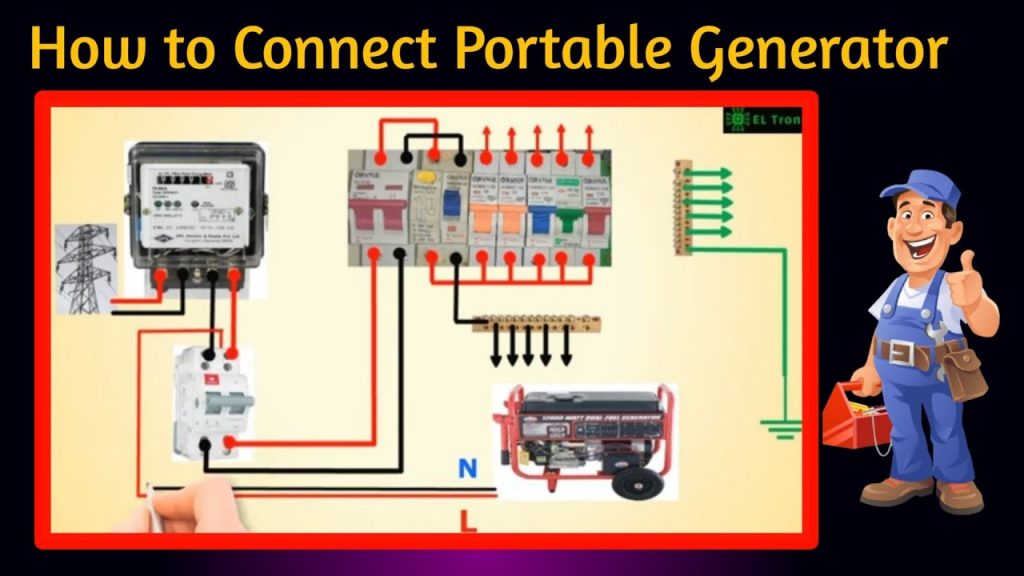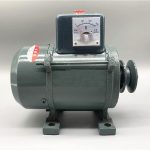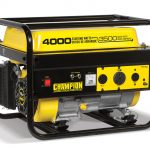Installing a portable generator is a great way to make sure your power supply is always available. But before you start the installation process, it is important to decide whether you need an electrician to install your generator or if you can do it yourself. If you are unfamiliar with electrical wiring, it is highly recommended to hire a professional electrician to help you with the installation. An electrician will be able to ensure that the installation is done safely, properly, and to code. It is important to remember that if you are using a portable generator to power an entire home, you must use an interlock kit that is installed by an electrician to ensure that your generator will not be connected to the main power grid.
This will help to protect both you and your property. When choosing an electrician, it is important to make sure that they are experienced in installing portable generators and have the proper licensing. It is also a good idea to check reviews from past customers to make sure that you are hiring a reliable company. Overall, it is highly recommended to hire an electrician to install a portable generator, as they will be able to safely and properly install your generator. This will help to ensure that your generator is properly connected and that you and your property are protected.
Can I install a generator myself?
If you are unsure of your own experience with wiring, it is best to enlist the help of a professional electrician. Before beginning the installation process, make sure you have all the necessary components, such as the generator itself, a transfer switch, and any other wiring hardware. It is also important to read the manufacturer’s instructions thoroughly. Once you have all of the components and instructions, you can begin the process. Depending on the type of generator, the installation process may range from a few hours to a full day.
When installing a portable generator, you should use caution when dealing with power and electrical wiring. Make sure you are aware of the safety protocols outlined by the generator’s manufacturer. In conclusion, yes, you can install a generator yourself, but it is recommended to consult with a professional electrician if you are uncertain of your own abilities or the manufacturer’s instructions.
How big of a portable generator do you need to run a house?
Installing a portable generator can be a great way to provide electricity to your home in the event of a power outage. But, before you start the installation process, it’s important to determine how big of a generator you need. When it comes to powering an entire house, the answer is quite simple. You’ll need to get a larger generator than you would for just a few appliances or lights. The size of generator you’ll need depends on the size of your house and the number of appliances and lights you want to be able to run.
If you’re looking to power an entire house, you’ll need a generator that can produce at least 8,000 to 10,000 watts of power. This should be enough power to keep your refrigerator, central air conditioner, water heater, sump pump, and a few other appliances running. On the other hand, if you’re looking for just a few appliances to be operational during a power outage, you could get away with a smaller generator, such as one with 4,000-6,000 watts. No matter what size of generator you choose, it’s important to install it properly. Be sure to read the manufacturer’s instructions carefully and install the generator according to those instructions. With proper installation and usage, you can be sure that your portable generator will keep the lights on during a power outage.
What size generator is needed to run an average house?
But before you make a purchase, you need to know what size generator is needed to run an average house. An average home would need a generator rated between 7500 and 12500 watts. This power can be used to run large appliances such as a refrigerator and a washer/dryer, as well as lights, fans, and other small appliances. When choosing a generator, you should consider the total wattage of all the items you want to power. A larger generator can provide more power and will be more reliable during extended power outages.
When it comes to installation, portable generators are relatively straightforward to install. You need to make sure that the generator has enough space to run safely and is far away from any buildings or combustible materials. The generator should be connected to the house via an outdoor power inlet and then directed to the circuit breaker panel. Ultimately, the size of the generator you need depends on what items you’re wanting to power in your home. For larger homes, you may need a generator with a higher wattage rating. Make sure to research your options and select a generator that is the right size for your home.
Can I just plug a generator into an outlet?
But before you do, it’s important to know the answer to the question: can I just plug a generator into an outlet? The answer is no. Portable generators need to be wired into the electrical system of your home for them to be safely used. This ensures that all of the circuits in your home are properly protected from any potential power surges. To install a portable generator, you’ll need to connect it to an external power inlet. This inlet will be wired directly to your home’s main service panel.
This process should only be done by a qualified electrical technician, as it can be dangerous to work with electricity. Once the generator is wired into the system, it will need to be connected to a transfer switch. This switch will allow you to control when the generator is providing power to your home. It will also ensure that when the generator is not running, your home is still connected to your utility company’s power lines. Finally, the transfer switch needs to be connected to your home’s main service panel. Once all of these steps are completed, your portable generator will be ready to use during an outage. By following these steps, you can ensure that your generator is safely and properly installed.
Do I need an electrician to connect a generator to my house?
Installing a portable generator to your home requires professional help and expertise. An electrician is needed to ensure that the connection is properly done and to make sure that safety measures are in place. Without a professional, you could be running the risk of damaging your home’s electrical system, or even injuring yourself. The electrician will first check that the generator is compatible with your home’s electrical system. Then they will inspect your home to determine the best and safest location to install the generator and the transfer switch.
The switch is necessary to disconnect the home from utility electricity when the generator is on. The electrician will also install and connect the generator to the transfer switch. They will then set up the generator with the necessary fuel supply and connect it to the appropriate outlets. Finally, the electrician will inspect the entire system to make sure that everything is hooked up correctly and safely. Having a professional electrician handle the installation of a portable generator into your home is a necessary and important step. Not only will it ensure that the generator is installed safely, but it will also give you the peace of mind that it’s working properly and ready to power your home in the event of a power outage.
How do you hook up a portable generator?
Installing a portable generator is relatively easy and can provide you with a lot of convenience in a power outage situation. Here is how to hook it up in just a few steps:
- Make sure the generator is at least 10 feet away from the house. This is to ensure that the exhaust gases from the generator don’t get into the house.
- Locate the main power source in your home and turn off the power at the circuit breaker.
- Connect the generator to the transfer switch using the provided cords.
- Turn on the generator and make sure it is running properly.
- Flip the breakers on the transfer switch one at a time, starting with the essentials like refrigerator and lights.
- Lastly, plug in any other necessary items you may need. By following these simple steps, you can easily and safely hook up your portable generator.
How to connect a portable generator to a house?
Installing a portable generator to your house can provide a valuable source of backup power during a blackout or power outage. Here is a step-by-step guide to connecting your portable generator to your house.
- Start by purchasing the appropriate transfer switch for your generator and house. Make sure to get a transfer switch that is compatible with your generator’s wattage.
- Turn off the main power switch to your house. This switch should be located in your circuit breaker box.
- Connect the transfer switch according to the instructions provided by the manufacturer.
- Install the generator near your house, making sure that it is at least 20 feet away from any windows or doors.
- Connect the generator to the transfer switch using the appropriate power cables.
- Start the generator and ensure that it is working properly.
- Turn on the main power switch on your house and check to make sure that the power is flowing. Your portable generator should now be safely and successfully connected to your house. Enjoy the peace of mind knowing that you have a reliable source of backup power.
How do you connect a generator to a home?
Here is a guide on how to connect a generator to your home:
- Make sure your generator is properly installed in an outdoor area that is away from any open windows or vents. Ensure that the generator is on a flat, level surface and is connected to an exhaust pipe to vent dangerous fumes away from your home.
- Connect the generator to your home’s main electrical panel. You will need to use a double-pole transfer switch, which is the safest way to connect the generator to your panel. Make sure to shut off all power to the panel before doing any work, then connect the transfer switch to the incoming service lines.
- Connect the generator to an outdoor receptacle. This will require a heavy-duty outdoor cord, which should be rated for outdoor use and for use with a generator. Make sure the cord is properly secured to the generator and the receptacle.
- Ensure that the generator is properly grounded. Connect a ground wire from the generator to a metal stake in the ground. This is an important safety feature, as it prevents electric shock from the generator.
- Once all of the connections are made, you can start up the generator and turn on the circuit breakers in the transfer switch. Make sure to test the circuit breakers first to ensure that they are working correctly. After everything is connected, you should be able to use your generator to power your home.
Can I install the generator myself?
If you’re wondering if you can install the generator yourself, the answer is yes! Installing a portable generator can be done without the need to hire a professional. However, it is important to understand the process and safety precautions that come along with the installation. Before you get started, make sure you read the instructions in the user manual for the generator. This will help you understand the necessary steps for installation, as well as provide safety information. You’ll also want to make sure that you have the right tools and supplies for the installation, including a flathead screwdriver, pliers, and a voltage meter.
Once you have all of the necessary supplies, you can begin the installation process. This may require some basic wiring to connect the generator to your home’s power grid. It’s important to be aware of the proper safety precautions while doing this, as electricity can be dangerous. Overall, installing a portable generator yourself is possible, however, you should take the time to understand the process and safety guidelines thoroughly. This will ensure that your generator is installed correctly and safely.
Can a portable generator be wired to house?
Installing a portable generator to power your home is possible and not a difficult task. Depending on the size of the generator and the electrical load of your home, you may need to hire a qualified electrician to install a transfer switch. A transfer switch is a switch that safely disconnects your home from the power grid and connects it to the generator. This allows you to use the generator to power the circuits in the home without having to run extension cords. Portable generators come in many sizes, from small 1000-watt generators to large 10,000-watt generators.
You will need to determine the size of the generator you will need to power the appliances and circuits in your home. Once you have determined the size of the generator you need and have installed a transfer switch, you can then wire the generator to the transfer switch. Once it is connected, you can then test the generator to make sure it is working properly. Once the generator is tested and working correctly, you can then turn it on and test each circuit to make sure they are receiving power. This will ensure that everything in your home is powered safely and efficiently.
How do you hook up a generator to Your House?
Before getting started, you will need to purchase the proper equipment such as an extension cable, transfer switch, and outlet. Begin by connecting the generator to the transfer switch with the extension cable. Make sure the switch is in the off position and the generator is off. Once the cable is securely connected, turn on the generator. Next, turn on the transfer switch, which will allow you to access the power generated from the generator.
You will need to check the voltage and hertz from the generator to make sure it is compatible with your home’s circuits. Once the transfer switch is on and the generator is running properly, you can connect the generator to your house’s electrical system. To do this, you will need to connect the generator cord to an outlet in your home. Make sure the outlet is correctly grounded and is compatible with the generator’s voltage and hertz. Finally, you can safely turn on the electricity from the generator. Make sure the generator cord is securely connected and all switches are in the on position. Now you can enjoy the peace of mind that comes with having a reliable power source in case of an emergency.
How to connect a generator to house without transfer switch?
Installing a portable generator to your home without a transfer switch can be a time-consuming process, but it is one that can be done safely and efficiently. The first step is to shut the main power switch off. This is the switch that distributes electricity to the whole house. Once the main switch has been shut off, you should connect the ground wire from the generator to the grounding rod. Next, you should connect the generator to one of the breakers in the main circuit panel.
Make sure it is a breaker rated for the generator. It is best to use a double-pole 30-amp breaker for most homes. Once the breaker is connected, you can then connect the generator to the outside power outlet. If you have an existing power outlet, you can use a heavy-duty extension cord to plug the generator into the outlet. Finally, turn the generator on and check to make sure all the connections are secure. When you are confident that everything is connected properly, you can turn the generator off and turn the main power switch back on. This will allow you to safely use the generator for power when you need it.
How to hook up a generator to your house wiring?
First, you should determine which outlets you will be powering with the generator, and then turn off the circuit breakers that provide power to those outlets. Then, connect the generator’s long power cord to the outdoor socket outlet. Next, connect a heavy-duty outdoor extension cord to the generator. Make sure the cord is rated for outdoor use, and that all the connections are secure and weatherproof. After that, plug the extension cord into the outdoor socket.
Your generator should now be ready for use. Finally, when you want to use the generator, you’ll need to make sure the main power from your utility is disconnected, otherwise the generator can become damaged. Once you’ve done that, you can turn on the generator, and it will start sending power to the outlets connected to it. Ensure that all of your appliances are turned off before turning on the generator.
How to connect a portable generator to a home?
First, locate the generator in a well-ventilated area, away from windows, doors and vents that lead into your home. Next, use heavy-duty outdoor extension cords to connect the generator to your home’s electrical panel. Make sure the generator is properly grounded before plugging it in. Then, turn off the main breaker in your electrical panel and plug the generator’s power cord into a receptacle on the outside of the panel. Once that is complete, turn on the main breaker, then the generator, and power will be restored to your home. Be sure to never overload the generator and use the correct wattage for your appliances. This will help prevent any damage to your home, appliance and the generator.






